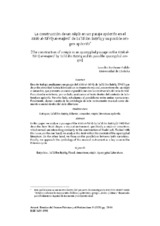La construcción de un nāqūs en un pasaje apócrifo en el Kitāb al-Tāʼrīḫ al-maǧmūʽ de Saʽīd ibn Baṭrīq y su posible origen apócrifo
The construction of a nāqūs in an apocryphal passage in the Kitāb al-Tāʼrīḫ al-maǧmūʽ by Saʽīd ibn Baṭrīq and its possible apocryphal origin
Autor
Bonhome Pulido, Lourdes
Editor
UCOPressFecha
2020Materia
EutiquioSaʽīd Ibn Baṭrīq
Diluvio
Simandro
Nāqūs
Literatura apócrifa
Eutychius
Flood
Simantron
Apocryphal literature
METS:
Mostrar el registro METSPREMIS:
Mostrar el registro PREMISMetadatos
Mostrar el registro completo del ítemResumen
En este trabajo analizamos un pasaje del Kitāb al-Tāʼrīḫ de Saʽīd ibn Baṭrīq (†940) que describe cómo Noé habría fabricado un instrumento musical, concretamente, un nāqūs o simandro, que presenta un curioso paralelismo con la construcción del arca de Noé. Para abordar este tema, por un lado, analizamos el texto dentro del contexto de la literatura apócrifa. Por otro lado, estudiamos el paralelismo entre ambas narraciones. Finalmente, damos cuenta de la simbología de este instrumento musical como elemento esencial dentro del ciclo diluviano. In this paper we analyse a passage of the Kitāb al-Tāʼrīḫ by Saʽīd ibn Baṭrīq (d. 940) that describes how Noah shapes a musical instrument, specifically a nāqūs or simantron, which reveals an interesting similarity to the construction of Noah’s ark. To deal with this issue, on the one hand, we analyse this text within the context of the Apocryphal literature. On the other hand, we focus on the parallelism between both narrations. Finally, we approach the symbology of this musical instrument as a key issue in the Diluvian cycle.

